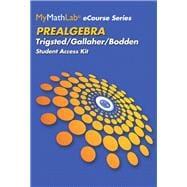This package contains the Access Kit for the Trigsted/Bodden/Gallaher MyMathLab eCourse plus the Guided Notebook.
Prealgebra by Trigsted, Gallaher, and Bodden is the first online, completely “clickable” prealgebra text to take full advantage of MyMathLab’s features and benefits. Kirk Trigsted saw marked improvements in student learning when he started teaching with MyMathLab, but he noticed that most students started their assignments by going directly to the MyMathLab homework exercises without consulting their textbook. This inspired Kirk to write a true eText, built within MyMathLab, to create a dynamic, seamless learning experience that would better meet the needs and expectations of his students. Completely clickable and fully integrated—the Trigsted eText is designed for today’s learners.
Prealgebra is also available with two printed resources to provide additional support for you:
- The eText Reference is a spiral-bound, printed version of the eText that provides a place for students to do practice work and summarize key concepts from the online videos and animations. In addition to the benefits it provides students, the eText Reference is also a nice resource for those instructors that prefer a printed text for class preparation.
- The Guided Notebook is an interactive workbook that guides students through the course by asking them to write down key definitions and work through important examples for each section of the eText. This resource is available in a three-hole-punched, unbound format to provide the foundation for a personalized course notebook. Students can integrate their class notes and homework notes within the appropriate section of the Guided Notebook. Instructors can customize the Guided Notebook files found within MyMathLab.








